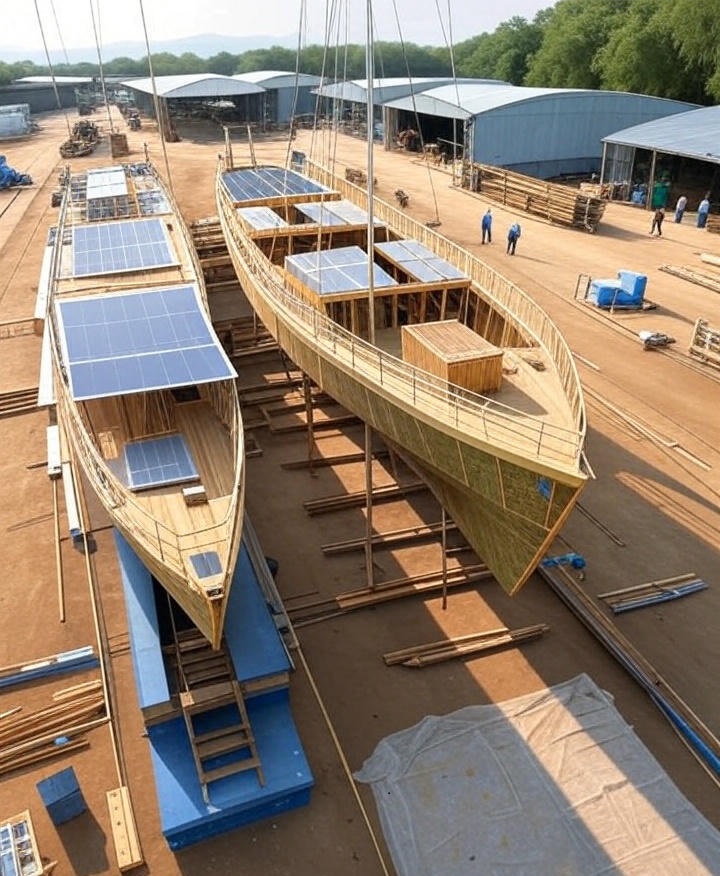
In an era where environmental consciousness steers global industries, green shipbuilding emerges as a beacon of innovation, reshaping maritime engineering with eco-friendly practices. As the world grapples with climate change, the maritime sector—responsible for nearly 3% of global greenhouse gas emissions—is under pressure to adopt sustainable shipbuilding techniques. This blog explores how the industry is navigating toward a greener horizon, weaving in cutting-edge technologies and strategies to reduce its ecological footprint while boosting efficiency.
Why Green Shipbuilding Matters
The maritime industry is the backbone of global trade, ferrying over 80% of goods worldwide. Yet, its reliance on fossil fuels and traditional construction methods has left a hefty environmental toll. Eco-conscious shipbuilding addresses this by prioritizing renewable energy, resource efficiency, and reduced emissions. By embracing sustainability in maritime design, shipbuilders can curb pollution, comply with stringent regulations like the IMO’s 2050 net-zero target, and appeal to eco-savvy stakeholders.
Key Drivers of Change
- Regulatory Pressure: International Maritime Organization (IMO) mandates push for lower sulfur emissions and carbon-neutral goals.
- Market Demand: Shipowners and consumers demand environmentally friendly vessels to align with corporate social responsibility.
- Technological Innovation: Advances in green maritime technology make sustainable solutions viable and cost-effective.
Innovations Anchoring Green Shipbuilding
1. Eco-Friendly Materials
Traditional shipbuilding leans on steel and other high-impact materials. Green shipbuilding pivots to recyclable composites, bio-based resins, and lightweight alloys. These materials reduce vessel weight, slashing fuel consumption and emissions. For instance, recycled aluminum and sustainable timber are gaining traction for their low environmental impact and durability.
2. Alternative Propulsion Systems
The heart of green vessels lies in their propulsion. Hybrid propulsion and electric ship engines powered by batteries or hydrogen fuel cells are replacing diesel engines. Wind-assisted propulsion, like rotor sails and kite systems, harnesses renewable energy, cutting fuel use by up to 20%. These systems align with zero-emission shipping goals, making waves in the industry.
3. Energy-Efficient Designs
Hull optimization and hydrodynamic coatings minimize water resistance, boosting fuel efficiency. Air lubrication systems, which create a bubble layer beneath the hull, reduce drag by up to 15%. Additionally, solar panels and waste heat recovery systems transform ships into floating powerhouses, harnessing renewable energy on the high seas.
4. Digitalization for Sustainability
Smart technologies like AI-driven route optimization and IoT-enabled monitoring enhance operational efficiency. These tools analyze weather, currents, and fuel consumption in real time, ensuring energy-efficient voyages. Digital twins—virtual ship models—allow builders to test eco-friendly designs before construction, minimizing waste.
Challenges in Green Shipbuilding
While the tide is turning, sustainable maritime construction faces hurdles:
- High Initial Costs: Eco-friendly materials and technologies require significant upfront investment.
- Infrastructure Gaps: Ports lack widespread support for alternative fuels like hydrogen or ammonia.
- Skilled Workforce: Transitioning to green methods demands retraining shipyard workers.
Despite these challenges, the long-term benefits—lower operating costs, regulatory compliance, and enhanced brand reputation—make the shift worthwhile.
The Future of Green Shipbuilding
The horizon glows with promise. Carbon-neutral ships powered by green hydrogen or ammonia are in development, with prototypes expected by 2030. Collaborative initiatives, like the Global Maritime Forum, are fostering partnerships to scale sustainable practices. Moreover, circular shipbuilding—designing vessels for easy disassembly and recycling—could redefine the industry’s lifecycle approach.
How Stakeholders Can Contribute
- Shipbuilders: Invest in R&D for low-carbon shipbuilding and adopt modular designs.
- Policymakers: Offer subsidies and tax incentives for green maritime projects.
- Consumers: Support companies prioritizing eco-conscious shipping to drive demand.
Conclusion
Green shipbuilding is not just a trend—it’s a revolution steering the maritime industry toward a sustainable future. By embracing innovative ship design, alternative fuels, and smart technologies, the sector can reduce its environmental wake while staying competitive. As we sail into a greener tomorrow, the question isn’t whether the industry will adapt, but how swiftly it can chart the course.








